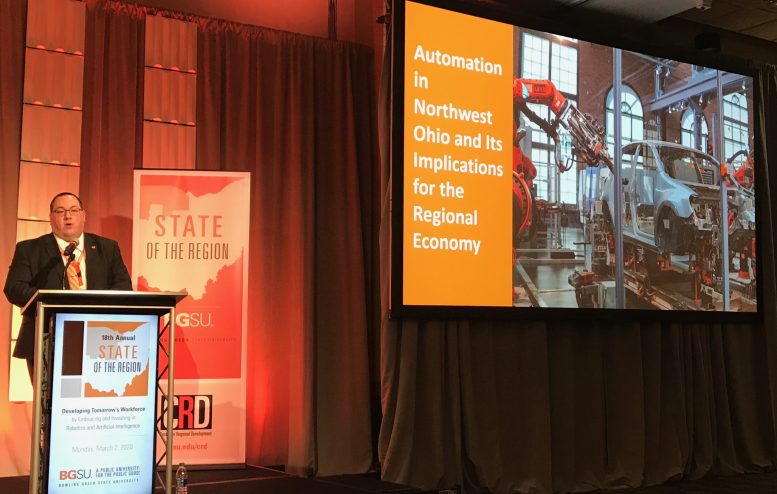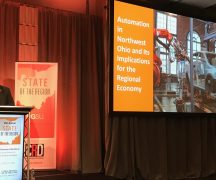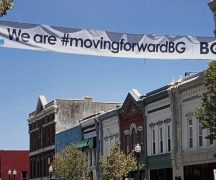By DAVID DUPONT
BG Independent News
The talk hereabout has been about finding enough workers to fill manufacturing jobs. Events are held to convince young people that these aren’t the grimy labor of earlier generations, and they should consider them, even if it means foregoing higher education.
In his State of the Region analysis delivered earlier this week, Russell Mills, senior director at Center for Regional Development, said that given the current realities, which include the need to find 1,000 workers for the soon to open Amazon fulfillment center in Rossford, such a focus is needed, especially in a tight job market.
But those working in economic development and workforce training need to face emerging realities.
Those jobs in manufacturing, transportation, and warehousing are the most likely to be automated.
Workers with a high school education or less are most in danger of losing employment to robots.
Those with bachelor’s degrees or greater are less susceptible.
Mills delivered his remarks as part of The State of the Region Conference presented by The Center for Regional Development at Bowling Green State University. The theme was “Developing Tomorrow’s Workforce by Embracing and Investing in Robotics and Artificial Intelligence.”
Mills presented an overview of economic developments over the past five years and a look at what’s to come in the next decade.
Looking ahead 10 years, a lot of the occupations that will have more workers than job openings “are ones we’ve focused a lot of our time on in terms of workforce development,” Mills said. Those include jobs in manufacturing, transportation, and warehousing. “A lot of those, if we believe the data on automation, will have a higher potential to be automated in the next 10 years.”
The region is caught in a dilemma. Those are the jobs that are here, having been attracted to the area. “That’s the base of our economy,” Mills said. “It’s not an either-or. But at the same time we need to diversify, particularly in our occupations and the way we attract jobs to region.”
Those areas that are projected to have shortfalls are in health care, computer occupations, and engineers — all of which require college degrees.
In health care alone the region is expected to need more than 400 new hires a year over the next decade, including 150 registered nurses.
This is a region that lags behind both the state and even more so the nation in levels of academic attainment.
The 17-county Northwest Ohio Region has 21.5 percent of its population with a bachelor’s degree or more while 47 percent of the population has a high school diploma or less. Wood County leads the region with 31.2 percent with a bachelor’s degree or more. The state has 26.8 percent at that level and the national figure is 30.4 percent.
Northwest Ohio is a region heavily invested in sectors such as automotive manufacturing and chemicals that are expected to lose employment.
In the last five years, job growth in the Toledo Metropolitan Statistical Area has been 1.69 percent, an increase of 1,455 jobs. Wood County added the most, 1,085, a 5.2 percent increase, the majority in manufacturing.
The robots, Mills said, are already here. Looking at the 100 largest MSAs, Toledo has the greatest concentration of robots, 9 for every 1,000 workers. Detroit is second with 8.5 robots per 1,000 workers, and Grand Rapids Michigan is third with 6.3 per 1,000.
The state’s job growth was 3 percent; the nation’s 5.26 percent, according to Economic Modeling Specialists International, Mills’ key source.
Looking at six other comparable areas around the country, the Toledo MSA is third from the bottom, with job growth about half of Springfield, Massachusetts, the area just ahead of it, which had 3.6 percent job growth. The best growth comes from the area Mills referred to as “the Golden Boy of MSAs, Boise, Idaho” where “every industry is expected to grow.”
Boise had 14.3 percent job growth.
In general the Mountain West is leading in growth. “People like mountains and outdoor activities,” he said.
This region is also losing population. Northwest Ohio is expected to lose almost 0.8 percent in population. Only Southeast Ohio will lose more, 1.1 percent.
The state as a whole will gain just under 1 percent, with Central Ohio gaining the most, almost 5 percent.
Mills noted that many of those who leave Northwest Ohio end up in Central Ohio, where there are both job growth and higher wages, though a somewhat higher cost of living.
Wood County is one of two counties in the region gaining population, experiencing a 1.4 percent rise. Hancock County also saw an increase of about 0.6 percent. Of the national MSA comparison group, Toledo is last, the only area losing population, lagging behind even Akron area, which has stagnant population. Again Boise was an over performing outlier at 10.3 percent growth with Durham, North Carolina second at 5.9 percent growth.
Still even with static population growth, housing can be an issue. Wood County has a 93.6 percent housing occupancy rate, and only 3.6 percent rental vacancy rate.
“We have to have affordable quality housing for people to live,” Mills said.
The trends, he said, should give economic development and workforce training people pause.
“Many people would view this as a threat,” he said. “But there is an opportunity here to align our educational institutions, our job attraction efforts, and work force development efforts, which frankly we’re in process of doing.”
In his opening remarks President Rodney Rogers noted that the university’s trustees had just approved a new major in systems engineering. This goes along with a focus on mechatronics and robotics and computer engineering.
Later in the week, BGSU announced a new online program with Northwest State Community College to help registered nurses earn their bachelor’s degrees.
***



